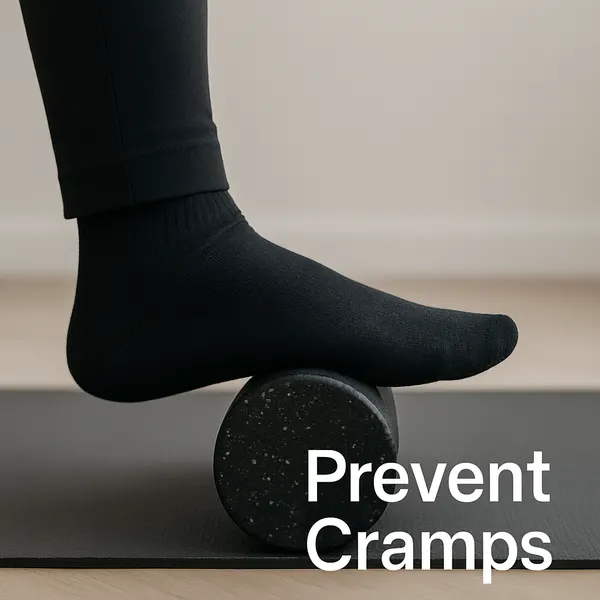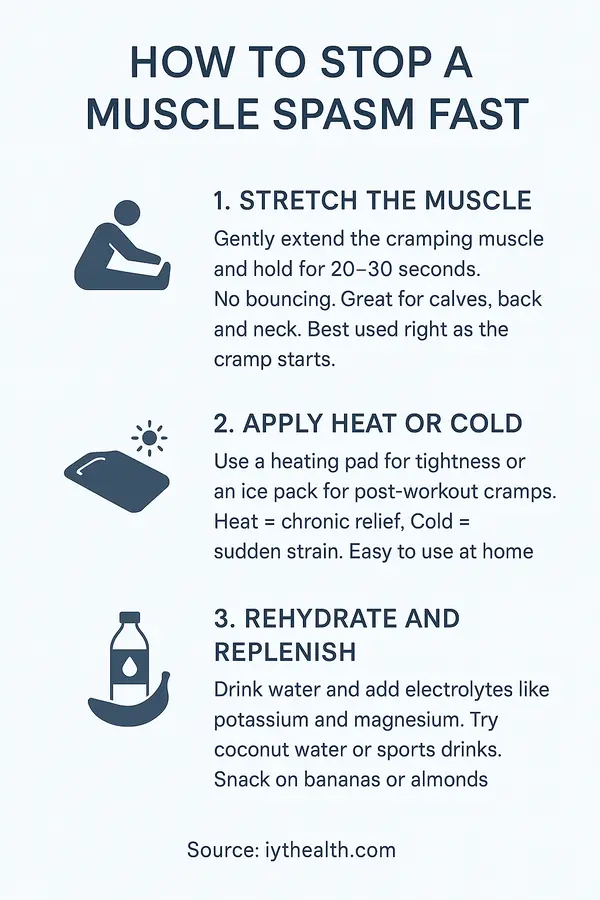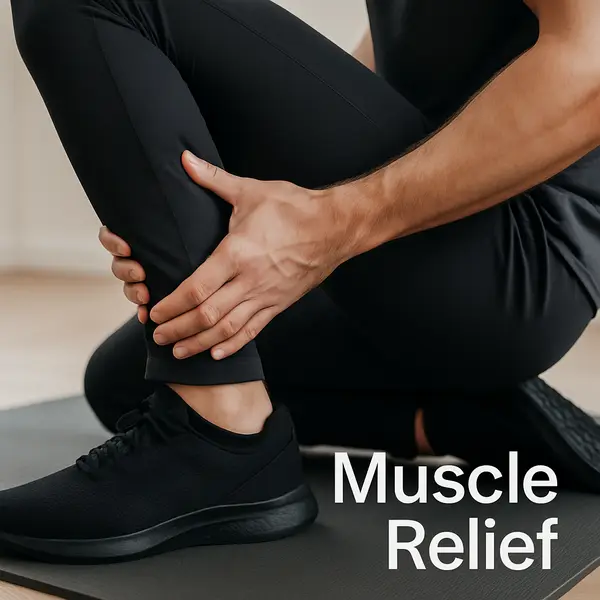A muscle spasm can hit out of nowhere—one minute you’re fine, the next you’re clutching your leg, back, or neck in sharp discomfort. These sudden contractions aren’t just painful—they can be downright disruptive. Whether you’re mid-run, mid-meeting, or sound asleep, muscle cramps have a knack for bad timing. The good news? You don’t have to suffer through them. With the right know-how and a few smart tricks, fast relief is totally within reach.
Muscle Cramp Prevalence Across Age Groups & Athletes
This chart compares muscle cramp prevalence across different age groups and endurance athletes. Notably, triathletes and cyclists report the highest rates, while adolescents experience cramps far less frequently.
What Causes Muscle Spasms?
Muscle spasms, also known as cramps, are involuntary contractions of one or more muscles. The American Academy of Orthopaedic Surgeons outlines various causes and prevention strategies for muscle cramps. [1] They can result from a variety of factors:
- Dehydration Muscle cells rely on adequate water levels to function properly. Dehydration doesn’t usually cause spasms while lounging on the couch—but if you’re exercising, working outside, or sweating excessively without replacing fluids, you’re at much higher risk. Symptoms often start with dry mouth, fatigue, or dizziness before a spasm strikes.
- Electrolyte imbalances (low levels of potassium, magnesium, calcium, or sodium) These minerals help conduct electrical impulses that control muscle movement. Imbalances can occur due to poor diet, excessive sweating, or use of diuretics. People may feel twitching, weakness, or more intense cramps when levels drop significantly.
- Overuse or fatigue of a muscle Doing too much too fast—especially without warming up—can overload a muscle. This commonly happens during intense workouts, long walks, or repetitive movements like lifting. A fatigued muscle loses coordination and may spasm as a protective response.
- Poor circulation or nerve compression Restricted blood flow limits oxygen delivery to muscle tissues, leading to spasms. This is more common in older adults or those with vascular conditions. Similarly, nerve pinching—such as from a herniated disc—can cause spasms as muscles misfire in response to irritation.
- Medical conditions such as multiple sclerosis, spinal cord injury, or hypothyroidism Chronic conditions often disrupt nerve signals or metabolism. In multiple sclerosis, for example, damaged nerve fibers can randomly activate muscles. Hypothyroidism may slow muscle recovery, causing stiffness and cramping even during rest.
Fun fact: According to the American Academy of Orthopaedic Surgeons, nearly 60% of adults experience muscle cramps, especially in the legs. A 2020 review in the Journal of the American Board of Family Medicine confirms the high prevalence of cramps among adults. [2]
Common Types of Muscle Spasms
- Calf cramps (also called “charley horses”) These are some of the most recognizable and painful types of muscle spasms. They often strike suddenly, especially at night or during physical activity, causing the calf muscle to tighten into a hard knot. People often describe the sensation as a deep, stabbing pain that may last from a few seconds to several minutes. These cramps can leave the leg sore even after the spasm ends.
- Neck and shoulder spasms These typically result from poor posture, stress, or long hours at a desk. The sensation is usually a dull ache or sharp twinge that radiates from the base of the skull or shoulder blades. Some people report a restricted range of motion, making it difficult to turn the head or lift objects. Stress-related tension is a common trigger.
- Back muscle spasms Spasms in the back often come on suddenly and can make even simple movements—like standing or walking—feel impossible. They are usually caused by muscle strain, disc problems, or nerve compression. The pain can be localized or radiate down to the legs, depending on the cause. This type of spasm can be particularly alarming because it often mimics more serious spinal conditions.
- Abdominal cramps (especially during exercise) These spasms are common during high-intensity workouts, particularly those involving the core. They’re usually described as a tight, twisting pain across the midsection, sometimes forcing a person to bend forward instinctively. Dehydration and overexertion are frequent culprits, and the discomfort can range from mild fluttering to intense cramping.
Each type may have a slightly different cause and require different treatment strategies, so recognizing the sensation and location can help guide more effective relief.
Prevalence of Muscle Cramps by Muscle Group
This chart displays how commonly different muscle groups are affected by cramps. Fingers and calves are the most frequently reported, while cervical and abdominal cramps are relatively rare.
Quick Fixes: How to Stop a Muscle Spasm Instantly
1. Stretch It Out
Stretching is often the first recommendation from sports medicine experts for acute cramps. [3]
When a spasm hits, the first and simplest move is to stretch the affected muscle slowly and gently. For a calf cramp, sit down, extend your leg, and flex your foot toward your shin—this elongates the muscle and tells it to chill out. Hold the stretch for at least 20–30 seconds, and don’t bounce. If it’s your neck or back, try leaning your head side-to-side or curling forward slowly. It works best if done immediately at the onset of a cramp and can be performed anywhere—at home, the gym, or even in the car (parked, of course).
Stretch accuracy: 8/10
Cost: $0
Cost: $0
2. Apply Heat or Cold
According to Mayo Clinic, temperature therapy can be especially effective when tailored to the cause of the spasm. [4]
Applying heat is ideal for relaxing tight muscles—think heating pad, hot water bottle, or even a warm shower aimed at the area. Heat should be applied for about 15–20 minutes, ideally while lying down in a quiet, comfortable space. On the other hand, if the cramp is caused by an injury or inflammation (like after a heavy workout), ice is your friend. Wrap a cold pack in a towel and apply it for 10–15 minutes. Heat is better for chronic tension; cold for acute pain or swelling.
Heat accuracy: 7/10 | Cold accuracy: 6/10
Average cost: $10-$40 (heating pad or reusable cold pack)
3. Massage the Area

Harvard Health Publishing notes that massage helps restore blood flow and relieve tension quickly. [5]
Massage helps by improving blood flow to the muscle and encouraging it to relax. Start with gentle circular motions using your fingers, moving slowly over the cramping area. For deeper relief, consider using a foam roller or massage gun like the Theragun PRO. You can do this on your own, but a partner or therapist can help with hard-to-reach spots like the back. Sessions usually last 5–10 minutes, and it’s safe to repeat as needed, unless pain worsens.
Massage accuracy: 8.5/10
Cost range: $0 (DIY) to $599 (premium massage devices)
4. Hydrate and Replenish Electrolytes
As emphasized in clinical guidance from UpToDate, maintaining fluid and mineral balance is crucial in cramp prevention and recovery. [6]
Dehydration is one of the most common causes of muscle spasms—especially if you’ve been sweating a lot. Drink a full glass of water immediately, then follow up with an electrolyte-rich beverage like Gatorade Zero or coconut water. If you’re at home, eating a banana or a handful of almonds can help restore potassium and magnesium levels. This approach is especially helpful after workouts or in hot climates, and it’s best to hydrate consistently throughout the day, not just during a cramp.
Hydration accuracy: 7.5/10
Cost: $1-$5
Medical Diagnosis: When It’s More Than Just a Cramp
If muscle spasms become chronic or severe, a medical diagnosis is essential. Here’s how healthcare providers investigate the cause:
1. Blood Tests
Used to detect electrolyte imbalances or underlying metabolic issues. A standard blood panel usually includes sodium, potassium, calcium, and magnesium levels. The test takes just a few minutes, and results are often available within 24–48 hours. Fasting may be required for some tests, so ask your doctor beforehand. It’s safe and suitable for nearly everyone.
- Accuracy: 9/10
- Cost: ~$100–$300
2. Electromyography (EMG)
Johns Hopkins Medicine describes EMG as one of the most effective diagnostic tools for uncovering nerve and muscle dysfunction. [7]
Assesses electrical activity in muscles to detect nerve or muscle disorders. Tiny needle electrodes are inserted into muscles, and electrical signals are recorded while the muscle is at rest and during contraction. The procedure takes about 30–60 minutes and can be mildly uncomfortable. No special prep is needed, and results are typically reviewed within a week. EMG is not ideal for patients on blood thinners unless cleared by a physician.
- Accuracy: 9.5/10
- Cost: ~$200–$1,200
3. MRI or CT Scans
RadiologyInfo.org highlights that imaging scans can clarify structural issues that might be causing persistent spasms. [8]
Used if nerve compression or structural issues are suspected. MRI provides high-resolution images of soft tissues, while CT scans are better for viewing bones. An MRI session lasts 30–45 minutes and requires lying still in a narrow tube—uncomfortable for those with claustrophobia. CT scans are quicker but involve exposure to radiation. Both usually require no special prep, though metal implants may limit MRI use.
- Accuracy: 9/10
- Cost: $600–$3,000
Real Patient Stories: Muscle Spasms in Real Life
Case 1: Back Spasms from a Desk Job – Atlanta, GA
Brian, 52, works in finance and spends 10+ hours a day at his desk. Over time, he developed frequent lower back spasms that disrupted his sleep and work focus. After a series of diagnostic tests including EMG and MRI, he was found to have a herniated disc pressing on a spinal nerve. With targeted physical therapy and a short course of muscle relaxants, his spasms decreased by over 70% in just six weeks.
Case 2: Dehydration and Cramps – Phoenix, AZ
Maria, 34, is a fitness enthusiast and group instructor in the Arizona heat. She began experiencing painful calf cramps during and after workouts. Blood work showed low sodium and magnesium levels. Her doctor recommended increasing daily fluid intake with electrolyte-enhanced water and adjusting her pre-workout meals. Within two weeks of consistent changes, the cramps became a rare occurrence.
Case 3: Nighttime Leg Spasms – Buffalo, NY
Eleanor, 67, began waking up at night with intense cramping in both legs. Initially attributing it to aging, she consulted her physician after it started happening three to four times a week. Blood tests ruled out major deficiencies, but her doctor identified poor circulation and a lack of muscle activity before bed. A new evening routine of light stretching and compression socks significantly reduced the frequency of spasms.
Chronic Leg Cramp Prevalence in Seniors
This chart shows the prevalence of chronic leg cramps in older adults. Nearly one-third of individuals over 50 report nightly cramps, with significantly higher rates observed among seniors in primary care settings.
Treatment Options: From OTC to High-Tech
1. Over-the-Counter Solutions
Nonsteroidal anti-inflammatory drugs (NSAIDs), like ibuprofen, are commonly used to reduce inflammation and discomfort caused by mild to moderate muscle spasms. Adults typically take 200–400 mg every 4–6 hours, but they shouldn’t be used long-term without a doctor’s supervision. For those who prefer topical relief, creams and gels containing menthol or capsaicin (such as Biofreeze or Icy Hot) can be applied directly to the skin, offering localized pain relief without systemic effects.
Effectiveness: 6.5–7.5/10
Cost: $5–$25
Suitable for: Occasional spasms, mild discomfort
Not recommended for: People with NSAID sensitivity or skin irritation
2. Prescription Medications
Prescription muscle relaxants like cyclobenzaprine (Flexeril) are often taken at bedtime to prevent nighttime spasms or two to three times a day for more severe cases. They help interrupt the muscle contraction cycle but may cause drowsiness. For those with neurological disorders, baclofen is a go-to option that works on the central nervous system to ease persistent spasticity. However, it’s not a one-size-fits-all solution and can lead to fatigue or dizziness.
Effectiveness: 7.5–9/10
Cost: $10–$100/month (with prescription)
Suitable for: Chronic spasms, neurologically related muscle issues
Not recommended for: People operating heavy machinery or those sensitive to sedatives
3. Innovative Devices and Therapies
Transcutaneous electrical nerve stimulation (TENS) units deliver low-voltage electrical pulses to the skin, helping disrupt pain signals and encourage relaxation. These devices are used for about 20–30 minutes per session and are ideal for at-home therapy. H-Wave devices, which are more powerful and typically found in clinical settings, improve circulation and support muscle recovery—great for post-surgery or chronic pain management. Smart tech like the PowerDot 2.0 connects to your phone and guides you through tailored recovery programs, making it a good pick for athletes or tech-forward users.
Effectiveness: 7–9/10
Cost: $100–$600
Suitable for: Tech-savvy users, physical therapy support
Not recommended for: Those with implanted electrical devices (e.g., pacemakers)
Talk to your healthcare provider before starting any new treatment plan to ensure safety and compatibility with your health profile. [9]

Prevention: Say Goodbye to Recurring Cramps
| Preventive Method | How to Apply It | Effectiveness (1-10) |
|---|---|---|
| Daily stretching | Spend 5–10 minutes each morning and evening doing static stretches. Focus on calves, hamstrings, quads, and lower back. Hold each stretch for at least 20–30 seconds. | 8 |
| Hydration & electrolyte care | Drink 8–10 glasses (about 2–2.5 liters) of water daily. Add a pinch of sea salt after workouts or opt for electrolyte tabs like Nuun Sport. Eat a banana or a handful of almonds post-exercise. | 7.5 |
| Warm-up & cool-down | Always include 5–7 minutes of light cardio (like walking or slow cycling) before activity, and slow-paced stretching afterward. | 8 |
| Ergonomic posture | Adjust your chair so knees are at 90°, keep feet flat, and use a lumbar pillow. Stand and stretch every 45–60 minutes. | 7 |
Editorial Advice
When that sharp jolt of pain hits, it’s tempting to panic. But knowing what to do can make all the difference. Start by stretching and hydrating. If it keeps coming back, don’t ignore it—you might be missing an underlying issue.
Reyus Mammadli, medical consultant, recommends: “If spasms occur more than twice a week or interrupt your sleep, it’s time to get a full blood panel and a neuro assessment. Don’t just chase symptoms. Get the root cause.”
Pro Tip: Keep a small foam roller or massage ball in your gym bag or at your desk. It’s a game-changer.
Muscle spasms might be common, but suffering from them doesn’t have to be. With smart strategies and a little self-care, you can kick those cramps to the curb—fast.
About the Author
Reyus Mammadli is the author of this health blog since 2008. With a background in medical and biotechnical devices, he has over 15 years of experience working with medical literature and expert guidelines from WHO, CDC, Mayo Clinic, and others. His goal is to present clear, accurate health information for everyday readers — not as a substitute for medical advice.







